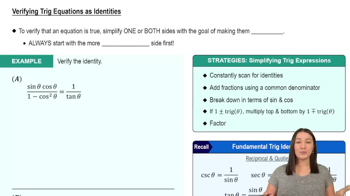Table of contents
- 0. Functions7h 52m
- Introduction to Functions16m
- Piecewise Functions10m
- Properties of Functions9m
- Common Functions1h 8m
- Transformations5m
- Combining Functions27m
- Exponent rules32m
- Exponential Functions28m
- Logarithmic Functions24m
- Properties of Logarithms34m
- Exponential & Logarithmic Equations35m
- Introduction to Trigonometric Functions38m
- Graphs of Trigonometric Functions44m
- Trigonometric Identities47m
- Inverse Trigonometric Functions48m
- 1. Limits and Continuity2h 2m
- 2. Intro to Derivatives1h 33m
- 3. Techniques of Differentiation3h 18m
- 4. Applications of Derivatives2h 38m
- 5. Graphical Applications of Derivatives6h 2m
- 6. Derivatives of Inverse, Exponential, & Logarithmic Functions2h 37m
- 7. Antiderivatives & Indefinite Integrals1h 26m
- 8. Definite Integrals4h 44m
- 9. Graphical Applications of Integrals2h 27m
- 10. Physics Applications of Integrals 2h 22m
1. Limits and Continuity
Finding Limits Algebraically
Problem 3.5.82
Textbook Question
Another method for proving lim x→0 cos x−1/x = 0 Use the half-angle formula sin²x = 1− cos 2x/2 to prove that lim x→0 cos x−1/x=0.
 Verified step by step guidance
Verified step by step guidance1
Start by recognizing that the limit we want to prove is lim x→0 (cos x - 1)/x = 0. This can be challenging directly, so we use trigonometric identities to simplify the expression.
Recall the half-angle identity: sin²x = (1 - cos 2x)/2. This identity can help us relate sine and cosine functions, which is useful for limits involving trigonometric functions.
To use this identity, consider the expression for sin²(x/2) = (1 - cos x)/2. This is derived by substituting x with x/2 in the half-angle formula.
Rearrange the expression to solve for cos x: cos x = 1 - 2sin²(x/2). This expression allows us to express cos x in terms of sin(x/2), which is useful for limits as x approaches 0.
Substitute cos x = 1 - 2sin²(x/2) into the original limit expression: (cos x - 1)/x = (1 - 2sin²(x/2) - 1)/x = -2sin²(x/2)/x. Now, analyze the behavior of this expression as x approaches 0, using the fact that sin(x/2) approaches 0 as x approaches 0.
 Verified video answer for a similar problem:
Verified video answer for a similar problem:This video solution was recommended by our tutors as helpful for the problem above
Video duration:
7mPlay a video:
Was this helpful?
Key Concepts
Here are the essential concepts you must grasp in order to answer the question correctly.
Limits
In calculus, a limit is a fundamental concept that describes the behavior of a function as its input approaches a certain value. It helps in understanding how functions behave near points of interest, particularly where they may not be explicitly defined. For example, evaluating the limit of a function as x approaches 0 can reveal insights about continuity and differentiability.
Recommended video:

One-Sided Limits
Trigonometric Identities
Trigonometric identities are equations that involve trigonometric functions and are true for all values of the variables involved. The half-angle formula, sin²x = (1 - cos(2x))/2, is a specific identity that relates the sine and cosine functions. These identities are essential for simplifying expressions and solving limits involving trigonometric functions.
Recommended video:

Verifying Trig Equations as Identities
L'Hôpital's Rule
L'Hôpital's Rule is a method in calculus used to evaluate limits of indeterminate forms, such as 0/0 or ∞/∞. It states that if the limit of f(x)/g(x) results in an indeterminate form, the limit can be found by taking the derivative of the numerator and the derivative of the denominator. This rule is particularly useful when direct substitution in limit problems leads to undefined expressions.
Recommended video:
Guided course

Power Rules

 5:21m
5:21mWatch next
Master Finding Limits by Direct Substitution with a bite sized video explanation from Callie
Start learningRelated Videos
Related Practice







